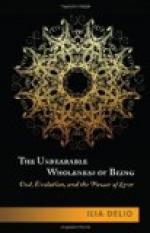It is quite in keeping with all this that our knowledge of this girl of eighteen is very vague and uncertain. Some of Dante’s commentators believe her to have been a figment of his brain, a woman who never lived, or an allegory of wisdom, virtue, the Church, theology, etc. But at the death of her father Beatrice again behaves like any other earthly maiden. There is a grain of truth in every one of these theories, for Dante was a great scholastic as well as a great poet, and in more advanced years he felt a need somehow to connect the love of his youth with the system of the Church; this could be done in an allegorical way without being inwardly untruthful.
Vague forces, which the lover himself realises as mysterious, run high in the Vita Nuova and in the poems; the lover has hallucinations in sleep and sickness. In the third canzone Dante speaks of the impossibility of comprehending what gave him a glimpse of the nature of his mistress. It was a foreboding of new and great things, struggling slowly and gradually to take shape, for the creation of a world-system, one of whose supporting pillars was personal love of an individual, was an unprecedented achievement. “When she speaks a spirit inclines from heaven.” The angels implore God to call this “miracle” into their midst, but God wills that they shall have patience until the “Hope of the Blessed” appears.
Love says of her can
there be mortal thing
At once adorned so richly
and so pure?
Then looks on her and
silently affirms
That heaven designed
in her a creature new.
(Transl. by C. LYELL.)
Again and again recurs the motif of her beauty before which the world must fall prostrate. In a sonnet not included in the Vita Nuova he says:
In heaven itself that
lady had her birth,
I think, and is with
us for our behoof;
Blessed are they who
meet her on the earth.
(Transl. by D.G. ROSSETTI.)




